How RAG Turns AI Chatbots Into Something Practical: The Secret Behind Reliable, Useful AI Assistants
For years, AI chatbots felt like brilliant but unreliable friends. They could write poetry, explain quantum physics, and even crack jokes—but ask them about your business, your latest blog post, or your client’s specific needs, and they’d either hallucinate confidently or reply with a generic, “I don’t have access to that information.”
That’s all changing in 2025. Thanks to a breakthrough technique called Retrieval-Augmented Generation (RAG), AI chatbots are finally becoming practical, trustworthy, and genuinely useful for real-world work—especially for solopreneurs, freelancers, and online businesses.
No longer limited to generic knowledge from 2023, RAG-powered chatbots can now access your documents, your data, and your context in real time—giving you accurate, personalized answers that actually help you get things done.
In this deep dive, we’ll explore exactly what RAG is, how it works under the hood, and—most importantly—how you can leverage it to transform your AI assistant from a party trick into a productivity powerhouse.
Why RAG Is the Missing Piece for Practical AI in 2025
Before RAG, even the most advanced AI models like GPT-4 or Claude had a fundamental limitation: they only knew what they were trained on. This meant:
- No knowledge of events after their training cutoff (e.g., GPT-4’s knowledge ends in April 2023)
- No awareness of your personal documents, business data, or niche expertise
- A tendency to “hallucinate” plausible-sounding but false answers when unsure
For casual users, this was annoying. For professionals who rely on accuracy—like bloggers, consultants, or developers—it was a dealbreaker.
RAG solves this by giving AI models a searchable memory. Instead of relying solely on internal knowledge, a RAG system:
- Retrieves relevant information from your custom data sources
- Augments the AI’s response with this real-time context
- Generates an answer that’s both intelligent and factually grounded
The result? An AI that knows your business, your content, and your goals—not just general trivia.
What Is RAG? (And How It Actually Works)
At its core, RAG is a simple but brilliant architecture that combines two powerful technologies:
The Retriever: Your AI’s Research Assistant
The retriever’s job is to find the most relevant pieces of information from your data when you ask a question. Here’s how it works:
- Your documents are converted into “embeddings”—mathematical representations of meaning (using models like OpenAI’s text-embedding-ada-002 or open-source alternatives like Sentence-BERT).
- These embeddings are stored in a vector database (like Pinecone, Weaviate, or Chroma) that can search by semantic similarity—not just keywords.
- When you ask a question, it’s also converted to an embedding and compared against your document library.
- The top 3–5 most relevant snippets are retrieved and passed to the AI.
This means the AI isn’t guessing—it’s answering based on your actual data.
The Generator: Your AI’s Spokesperson
The generator (usually a large language model like GPT-4 or Claude) takes the retrieved context and:
- Synthesizes a clear, concise answer
- Cites sources when appropriate
- Avoids making things up (since it has real data to work with)
The key innovation? The generator only uses the retrieved context—not its internal knowledge—for the parts of the answer that depend on your data.
A Real-World Example
Without RAG:
You ask: “What’s my refund policy for digital products?”
AI replies: “Most digital products have a 14-day refund policy, but I can’t access your specific policy.”
With RAG:
You ask: “What’s my refund policy for digital products?”
AI replies: “According to your website’s Terms page, digital products are non-refundable due to their instant delivery nature. However, you offer store credit for valid complaints within 7 days.”
This isn’t magic—it’s structured information retrieval.
How RAG Transforms Common Workflows for Online Earners
Let’s get practical. Here’s how RAG makes AI genuinely useful for your daily work.
For Bloggers and Content Creators
Problem: You have a library of 100+ blog posts, but you can’t remember what you’ve covered or where.
RAG Solution:
- Connect your blog’s content to a RAG system
- Ask: “Have I written about AI tools for affiliate marketing?”
- Get a precise answer with links to relevant posts
- Ask: “Summarize my top 3 tips for making money with AI”
- Get a synthesized response pulled from your actual content
💡 Impact: Eliminates redundant content, speeds up research, and ensures consistency across your blog.
For Freelancers and Consultants
Problem: Clients ask questions about past projects, deliverables, or processes you’ve documented in emails or Notion.
RAG Solution:
- Index your client communications, contracts, and project docs
- Ask: “What did I promise Client X in their onboarding call?”
- Get the exact quote from your meeting notes
- Ask: “What’s my standard rate for website design?”
- Get your current pricing from your rate sheet
💡 Impact: Reduces time spent searching, prevents miscommunication, and builds client trust through accuracy.
For Digital Product Sellers
Problem: Customers have questions about your templates, courses, or eBooks that require specific knowledge of your product.
RAG Solution:
- Upload your product documentation, FAQs, and tutorials
- Deploy a RAG-powered chatbot on your sales page
- Customers ask: “Does this Canva template include Instagram Stories?”
- Chatbot replies with the exact feature list from your product description
💡 Impact: Cuts support tickets by 50%+ and increases conversions through instant, accurate answers.
For Course Creators
Problem: Students in your course have questions that are answered somewhere in your 20-hour video library—but you can’t expect them to rewatch everything.
RAG Solution:
- Transcribe your course videos and index the text
- Build a RAG-powered study assistant
- Students ask: “How do I set up the WordPress plugin you mentioned in Module 3?”
- Get a step-by-step answer with a link to the exact video timestamp
💡 Impact: Improves student success rates and reduces your support burden.
Building Your Own RAG System: A Step-by-Step Guide
The best part? You don’t need a PhD to implement RAG. Here’s how to get started.
Step 1: Prepare Your Data
RAG works best with text-based, well-structured data:
- Blog posts (export as Markdown or HTML)
- PDFs (use OCR if scanned)
- Notion pages (export as Markdown)
- Google Docs (download as text)
- Emails (export as .eml or text)
🔗 Pro Tip: Use Google’s Structured Data Markup Helper to ensure your content is well-organized.
Step 2: Choose Your Tools
You have two main options:
Option A: No-Code Platforms (For Non-Developers)
- Glean: Enterprise-grade, but has a free tier for individuals
- You.com: Offers RAG-powered personal knowledge bases
- Notion AI + Plugins: Emerging RAG integrations for Notion users
Option B: DIY with Open Source (For Tech-Savvy Users)
- Embedding Model: OpenAI API or open-source (e.g.,
all-MiniLM-L6-v2) - Vector Database: Chroma (free, local) or Pinecone (cloud, free tier)
- LLM: OpenAI GPT-4, Anthropic Claude, or open-source (Llama 3)
- Framework: LangChain or LlamaIndex (simplify RAG implementation)
Step 3: Implement the RAG Pipeline
Here’s a simplified workflow using LangChain (Python):
from langchain_community.document_loaders import WebBaseLoader
from langchain_text_splitters import RecursiveCharacterTextSplitter
from langchain_openai import OpenAIEmbeddings
from langchain_chroma import Chroma
from langchain_openai import ChatOpenAI
from langchain.chains import create_retrieval_chain
from langchain.chains.combine_documents import create_stuff_documents_chain
from langchain_core.prompts import ChatPromptTemplate
# 1. Load and split your data
loader = WebBaseLoader("https://smartaiblog.online")
docs = loader.load()
text_splitter = RecursiveCharacterTextSplitter(chunk_size=1000, chunk_overlap=200)
splits = text_splitter.split_documents(docs)
# 2. Create vector store
vectorstore = Chroma.from_documents(documents=splits, embedding=OpenAIEmbeddings())
retriever = vectorstore.as_retriever()
# 3. Set up the RAG chain
llm = ChatOpenAI(model="gpt-4o")
system_prompt = (
"You are an assistant for question-answering tasks. "
"Use the following pieces of retrieved context to answer the question. "
"If you don't know the answer, say that you don't know. "
"\n\n"
"{context}"
)
prompt = ChatPromptTemplate.from_messages(
[("system", system_prompt), ("human", "{input}")]
)
question_answer_chain = create_stuff_documents_chain(llm, prompt)
rag_chain = create_retrieval_chain(retriever, question_answer_chain)
# 4. Ask a question
response = rag_chain.invoke({"input": "What topics does Smart AI Blog cover?"})
print(response["answer"])Step 4: Deploy and Iterate
- Start with a small dataset (e.g., your last 10 blog posts)
- Test with real questions you’d actually ask
- Refine your chunking strategy (size, overlap) for better retrieval
- Add metadata (e.g., date, author, category) to improve filtering
Advanced RAG Strategies for Maximum Impact
Take your implementation to the next level with these pro techniques.
Strategy 1: Hybrid Search (Keyword + Semantic)
Combine traditional keyword search with semantic search to catch both exact matches and conceptual relevance:
- Use Elasticsearch or OpenSearch for keyword matching
- Use vector search for semantic understanding
- Blend results using a weighted score
This ensures you never miss critical information that might be phrased differently.
Strategy 2: Query Rewriting
Improve retrieval accuracy by expanding or clarifying user queries:
- User asks: “How do I make money?”
- Rewritten query: “What are the best methods to earn income online as a blogger in 2025?”
Use a small LLM to perform this rewriting before retrieval.
Strategy 3: Self-Query RAG
For complex questions, have the AI generate its own search queries:
- User asks: “Compare my AI tool recommendations from last month to this month.”
- AI generates sub-queries:
- “What AI tools did I recommend in April 2025?”
- “What AI tools did I recommend in May 2025?”
This handles multi-hop reasoning that basic RAG can’t.
Strategy 4: Continuous Indexing
Keep your RAG system up-to-date automatically:
- Set up webhooks to trigger re-indexing when you publish new content
- Use cron jobs to periodically crawl your site
- Implement change detection to only update modified documents
This ensures your AI always has the latest information.
How RAG Compares to Alternatives
| RAG | High (grounded in your data) | Real-time | Full control | Business-critical applications |
| Fine-Tuning | Medium (can still hallucinate) | Static (requires retraining) | High effort | Brand voice, style consistency |
| Prompt Engineering | Low (relies on model’s knowledge) | Static | Limited | Simple tasks, quick prototypes |
| Hybrid (RAG + Fine-Tuning) | Very High | Real-time | Maximum | Enterprise-grade AI assistants |
📊 Verdict: For most solopreneurs and small businesses, RAG offers the best balance of accuracy, freshness, and ease of implementation.
Potential Challenges (And How to Overcome Them)
Retrieval Quality Issues
Challenge: The retriever brings back irrelevant or incomplete context.
Solution:
- Experiment with chunk size (500–1000 tokens usually works best)
- Add metadata filtering (e.g., only retrieve from “Blog” category)
- Use re-rankers (like Cohere Rerank) to improve result ordering
Cost and Complexity
Challenge: Running RAG can be expensive or technically demanding.
Solution:
- Start with open-source models (Llama 3, Mistral) and local vector DBs (Chroma)
- Use caching to avoid reprocessing the same queries
- Leverage serverless platforms (Vercel, AWS Lambda) for cost-efficient scaling
Privacy Concerns
Challenge: Sending your data to third-party APIs.
Solution:
- Use local LLMs (via Ollama or LM Studio) for sensitive data
- Choose vector DBs that run on your machine
- Implement data anonymization before processing
Frequently Asked Questions (FAQs)
What’s the difference between RAG and fine-tuning?
RAG retrieves relevant information from your data at query time, while fine-tuning permanently modifies the AI’s weights to include your data. RAG is better for frequently changing information, while fine-tuning is better for style or tone consistency.
Do I need coding skills to use RAG?
Not necessarily. Tools like Glean, You.com, and emerging Notion AI plugins offer no-code RAG solutions. However, for full control and customization, basic coding skills are helpful.
How much does it cost to run a RAG system?
It depends on your setup:
- Open-source/local: Nearly free (just your hardware costs)
- Cloud-based: $10–$100/month for small-scale use (Pinecone free tier + OpenAI API)
- Enterprise: $500+/month for high-traffic applications
Can RAG work with images or PDFs?
Yes—but you’ll need to convert them to text first. Use OCR for scanned PDFs, and image captioning models (like BLIP-2) for images. The core RAG process works with any text data.
How accurate is RAG compared to human answers?
When implemented well, RAG can achieve 90–95% accuracy on factual questions—significantly higher than standard LLMs (which may hallucinate 20–30% of the time on niche topics).
What’s the biggest mistake people make with RAG?
Using poorly chunked data. If your text chunks are too small, they lack context; if too large, they dilute relevance. Start with 500–1000 token chunks and adjust based on testing.
Can I use RAG with my existing website?
Absolutely! Most RAG frameworks can crawl and index your live site automatically. Just ensure your content is accessible (not behind logins) and well-structured.
Does RAG work offline?
Yes—if you use local models (like Llama 3 via Ollama) and a local vector database (like Chroma). This is ideal for sensitive data or environments without internet.
Final Thoughts: Your AI Just Got a Brain (and a Memory)
RAG isn’t just a technical improvement—it’s the key to unlocking AI’s true potential for real work. By grounding AI responses in your actual data, RAG transforms chatbots from entertaining but unreliable companions into trusted, practical assistants that can genuinely help you run your business, create content, and serve clients.
The best part? You don’t need a massive budget or a team of engineers to get started. With today’s open-source tools and no-code platforms, any solopreneur can build a RAG system that makes their AI assistant 10x more useful.
So stop settling for generic answers. Give your AI access to your knowledge, your voice, and your expertise. The result won’t just be a smarter chatbot—it’ll be a true productivity partner that helps you work less and earn more.
🌟 Ready to Build Your Practical AI Assistant?
If this guide showed you the power of RAG:
- Share it with a fellow creator tired of AI hallucinations
- Leave a comment below with your first RAG use case
- Follow Smart AI Blog for more practical guides on leveraging cutting-edge AI to make money online in 2025
Your most useful AI is just one RAG system away.







